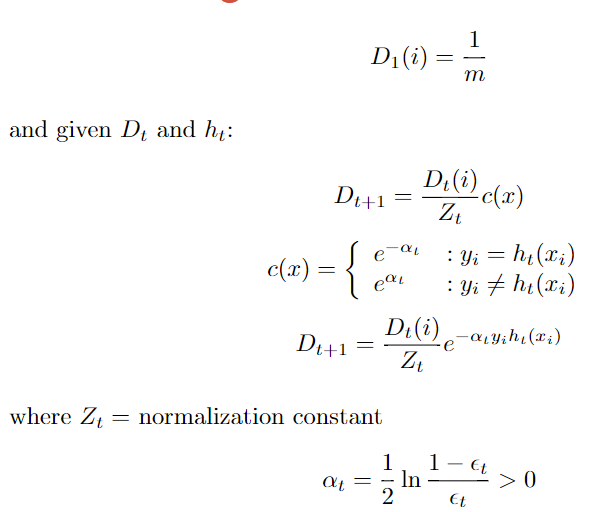Boosting AdaBoosting Algorithm
http://math.mit.edu/~rothvoss/18.304.3PM/Presentations/1-Eric-Boosting304FinalRpdf.pdf
Consider MIT Admissions

【qualitative quantitative】
•
2-class system (Admit/Deny)
•
Both Quantitative Data and Qualitative Data
•
We consider (Y/N) answers to be Quantitative (-1,+1)
•
Region, for instance, is qualitative.
Rules of Thumb, Weak Classifiers
Easy to come up with rules of thumb that correctly classify the training data at
better than chance.
•
E.g. IF “GoodAtMath”==Y THEN predict “Admit”.
•
Difficult to find a single, highly accurate prediction rule. This is where our Weak
Learning Algorithm,AdaBoost, helps us.
What is a Weak Learner?
【generalization error better than random guessing】
For any distribution, with high probability, given polynomially many examples and polynomial time we can find a classifier with generalization error
better than random guessing.

Weak Learning Assumption
•
We assume that our Weak Learning Algorithm (Weak
Learner) can consistently find weak classifiers (rules of
thumb which classify the data correctly at better than 50%)
•
【boosting】
Given this assumption, we can use boosting to generate a
single weighted classifier which correctly classifies our
training data at 99%-100%.
【AdaBoost Specifics 】
•
How does AdaBoost weight training examples optimally?
•
Focus on difficult data points. The data points that have been
misclassified most by the previous weak classifier.
•
How does AdaBoost combine these weak classifiers into a
comprehensive prediction?
•
Use an optimally weighted majority vote of weak classifier.
AdaBoost Technical Description

Missing details: How to generate distribution? How to get single classifier?
Constructing Dt

Getting a Single Classifier

分类:
algorithm





【推荐】国内首个AI IDE,深度理解中文开发场景,立即下载体验Trae
【推荐】编程新体验,更懂你的AI,立即体验豆包MarsCode编程助手
【推荐】抖音旗下AI助手豆包,你的智能百科全书,全免费不限次数
【推荐】轻量又高性能的 SSH 工具 IShell:AI 加持,快人一步
· Linux系列:如何用heaptrack跟踪.NET程序的非托管内存泄露
· 开发者必知的日志记录最佳实践
· SQL Server 2025 AI相关能力初探
· Linux系列:如何用 C#调用 C方法造成内存泄露
· AI与.NET技术实操系列(二):开始使用ML.NET
· 被坑几百块钱后,我竟然真的恢复了删除的微信聊天记录!
· 没有Manus邀请码?试试免邀请码的MGX或者开源的OpenManus吧
· 【自荐】一款简洁、开源的在线白板工具 Drawnix
· 园子的第一款AI主题卫衣上架——"HELLO! HOW CAN I ASSIST YOU TODAY
· 无需6万激活码!GitHub神秘组织3小时极速复刻Manus,手把手教你使用OpenManus搭建本
2016-11-01 ONLYstore_name+AdWord
2016-11-01 模拟信号 数字信号 模拟电路 数字电路
2016-11-01 MOSFET 功率半导体